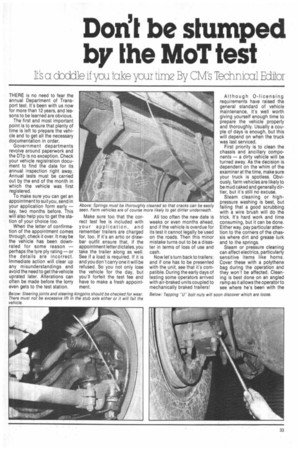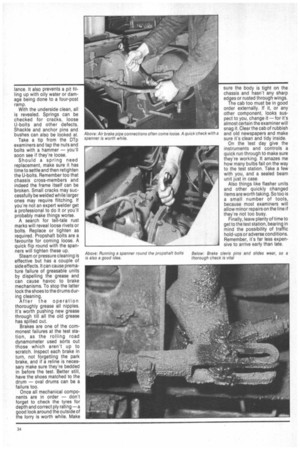Don't be stumped by the MoT test
Page 149

Page 150

If you've noticed an error in this article please click here to report it so we can fix it.
It's a Coddle if you ta-Ke your time By CV's Technical Editor
THERE is no need to fear the annual Department of Transport test. It's been with us now for more than 12 years, and lessons to be learned are obvious.
The first and most important point is to ensure that plenty of time is left to prepare the vehicle and to get all the necessary documentation in order.
Government departments revolve around paperwork and the DTp is no exception. Check your vehicle registration document to find the date for its annual inspection right away. Annual tests must be carried out by the end of the month in which the vehicle was first registered.
To make sure you can get an appointment to suit you, send in your application form early — say, two months before. This will also help you to get the station of your choice too.
When the letter of confirmation of the appointment comes through, check it over. It may be the vehicle has been downrated for some reason — perhaps the tyre ply rating — or the details are incorrect. Immediate action will clear up any misunderstandings and avoid the need to get the vehicle uprated later. Alterations can often be made before the lorry even gets to the test station. Make sure too that the correct test fee is included with your application, and remember trailers are charged for, too. If it's an artic or drawbar outfit ensure that, if the appointment letterdictates, you take the trailer along as well. See if a load is required. If it is and you don't carry one it will be refused. So you not only lose the vehicle for the day, but you'll forfeit the test fee and have to make a fresh appointment. All too often the new date is weeks or even months ahead, and if the vehicle is overdue for its test it cannot legally be'used on the roads. Then this minor mistake turns out to be a disaster in terms of loss of use and cash.
Now let's turn back to trailers: and if one has to be presented with the unit, see that it's compatible. During the early days of testing some operators arrived with air-braked units coupled to mechanically braked trailers! Although 0-licensing requirements have raised the general standard of vehicle maintenance, its well worth giving yourself enough time to prepare the vehicle properly and thoroughly. Usually a couple of days is enough, but this will depend on when the truck was last serviced.
First priority is to clean the chassis and ancillary components — a dirty vehicle will be turned away. As the decision is dependent on the whim of the examiner at the time, make sure your truck is spotless. Obviously, farm vehicles are likely to be mud caked and generally dirtier, but it's still no excuse.
Steam cleaning or highpressure washing is best, but failing that a good scrubbing with a wire brush will do the trick. It's hard work and time consuming, but it can be done. Either way, pay particular attention to the corners of the chassis where dirt and grease lurk and to the springs.
Steam or pressure cleaning can affect electrics, particularly sensitive items like horns. Cover these with a polythene bag during the operation and they won't be affected. Gleaning is best done on an angled ramp as it allows the operator to see where he's been with the lance. It also prevents a pit filling up with oily water or damage being done to a four-post ramp.
With the underside clean, all is revealed. Springs can be checked for cracks, loose U-bolts and other defects. Shackle and anchor pins and bushes can also be looked at.
Take a tip from the DTp examiners and tap the nuts and bolts with a hammer — you'll soon see if they're loose.
Should a spring need replacement, make sure it has time to settle and then retighten the U-bolts. Remember too that chassis cross-members and indeed the frame itself can be broken. Small cracks may successfully be welded while larger ones may require flitching. If you're not an expert welder get a professional to do it or you'll probably make things worse.
A search for tell-tale rust marks will reveal loose rivets or bolts. Replace or tighten as required. Propshaft bolts are a favourite for coming loose. A quick flip round with the spanners will tighten these up.
Steam or pressure cleaning is effective but has a couple of side effects. It can cause premature failure of greasable units by dispelling the grease and can cause havoc to brake mechanisms. To stop the latter lock the shoes to the drums during cleaning.
After the operation thoroughly grease all nipples. It's worth pushing new grease through till all the old grease has spilled out.
Brakes are one of the commonest failures at the test station, as the rolling road dynamometer used sorts out those which aren't up to scratch. Inspect each brake in turn, not forgetting the park brake, and if a reline is necessary make sure they're bedded in before the test. Better still, have the shoes matched to the drum — oval drums can be a failure too.
Once all mechanical components are in order — don't forget to check the tyres for depth and correct ply rating —a good look around the outside of the lorry is worth while. Make sure the body is tight on the chassis and hasn't any sharp edges or rusted through wings.
The cab too must be in good order externally. If it, or any other component, looks suspect to you, change it --for it's almost certain the examiner will snag it. Clear the cab of rubbish and old newspapers and make sure it's clean and tidy inside.
On the test day give the instruments and controls a quick run through to make sure they're working. It amazes me how many bulbs fail on the way to the test station. Take a few with you, and a sealed beam unit just in case Also things like flasher units and other quickly changed items are worth taking. So too is a small number of tools, because most examiners will allow minor repairs on the line if they're not too busy.
Finally, leave plenty of time to get to the test station, bearing in mind the possibility of traffic hold-ups or adverse conditions. Remember, it's far less expensive to arrive early than late.




























































































































































